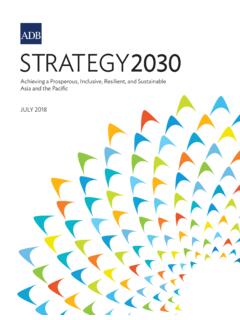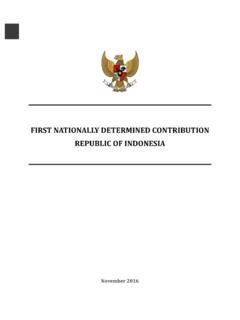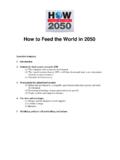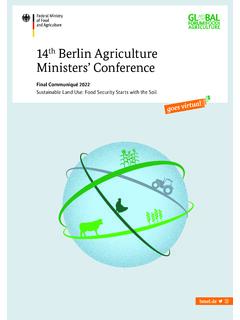Transcription of Farm to Fork Strategy - European Commission
1 For a fair, healthy and environmentally-friendly food system#EUGreenDealFarm to fork Strategy2 CONTENTS 1. NEED FOR 42. BUILDING THE FOOD CHAIN THAT WORKS FOR CONSUMERS, PRODUCERS, CLIMATE AND THE Ensuring sustainable food Ensuring food Stimulating sustainable food processing, wholesale, retail, hospitality and food services promoting sustainable food consumption and facilitating the shift to healthy, sustainable Reducing food loss and Combating food fraud along the food supply 153. ENABLING THE Research, innovation, technology and Advisory services, data and knowledge sharing, and 174.
2 promoting THE GLOBAL 185. CONCLUSIONS .. 20 ANNEX .. FOR ACTIONThe European Green Deal sets out how to make Europe the first climate-neutral continent by 2050. It maps a new, sustainable and inclusive growth Strategy to boost the economy, improve people's health and quality of life, care for nature, and leave no one behind. The farm to fork Strategy is at the heart of the Green Deal. It addresses comprehensively the challenges of sustainable food systems and recognises the inextricable links between healthy people, healthy societies and a healthy planet. The Strategy is also central to the Commission s agenda to achieve the United Nations sustainable development Goals (SDGs).
3 All citizens and operators across value chains, in the EU and elsewhere, should benefit from a just transition, especially in the aftermath of the COVID-19 pandemic and the economic downturn. A shift to a sustainable food system can bring environmental, health and social benefits, offer economic gains and ensure that the recovery from the crisis puts us onto a sustainable path1. Ensuring a sustainable livelihood for primary producers, who still lag behind in terms of income2, is essential for the success of the recovery and the COVID-19 pandemic has underlined the importance of a robust and resilient food system that functions in all circumstances, and is capable of ensuring access to a sufficient supply of affordable food for citizens.
4 It has also made us acutely aware of the interrelations between our health, ecosystems, supply chains, consumption patterns and planetary boundaries. It is clear that we need to do much more to keep ourselves and the planet healthy. The current pandemic is just one example. The increasing recurrence of droughts, floods, forest fires and new pests are a constant reminder that our food system is under threat and must become more sustainable and resilient. The farm to fork Strategy is a new comprehensive approach to how Europeans value food sustainability. It is an opportunity to improve lifestyles, health, and the environment.
5 The creation of a favourable food environment that makes it easier to choose healthy and sustainable diets will benefit consumers health and quality of life, and reduce health-related costs for society. People pay increasing attention to environmental, health, social and ethical issues3 and they seek value in food more than ever before. Even as societies become more urbanised, they want to feel closer to their food. They want food that is fresh, less processed and sustainably sourced. And the calls for shorter supply chains have intensified during the current outbreak. Consumers should be empowered to choose sustainable food and all actors in the food chain should see this as their responsibility and opportunity.
6 European food is already a global standard for food that is safe, plentiful, nutritious and of high quality. This is the result of years of EU policymaking to protect human, animal and plant health, and of the efforts of farmers, fishers and aquaculture producers. Now European food should also become the global standard for sustainability. This Strategy aims to reward those farmers, fishers and other operators in the food chain who have already undergone 1 At global level, it is estimated that food and agriculture systems in line with the SDGs would deliver nutritious and affordable food for a growing world population, help restore vital ecosystems and could create new economic value of over EUR trillion by 2030.
7 Source: Business & sustainable development Commission (2017), Better business, better For example, the average EU farmer currently earns around half of the average worker in the economy as a whole. Source: CAP Context indicator on Agricultural entrepreneurial income ( ).3 Europeans have a high level of awareness of food safety topics. Most frequently reported concerns relate to antibiotics, hormones and steroids in meat, pesticides, environmental pollutants and food additives. Source: Special Eurobarometer (April 2019), Food safety in the transition to sustainable practices, enable the transition for the others, and create additional opportunities for their businesses.
8 EU agriculture is the only major system in the world that reduced greenhouse gas (GHG) emissions (by 20% since 19904). However, even within the EU, this path has been neither linear nor homogenous across Member States. In addition, the manufacturing, processing, retailing, packaging and transportation of food make a major contribution to air, soil and water pollution and GHG emissions, and has a profound impact on biodiversity. As such, even though the EU s transition to sustainable food systems has started in many areas, food systems remain one of the key drivers of climate change and environmental degradation.
9 There is an urgent need to reduce dependency on pesticides and antimicrobials, reduce excess fertilisation, increase organic farming, improve animal welfare, and reverse biodiversity loss. The Climate Law5 sets out the objective for a climate neutral Union in 2050. The Commission will come forward by September 2020 with a 2030 climate target plan, to increase the GHG emission reduction target towards 50 or 55% compared with 1990 levels. The farm to fork Strategy lays down a new approach to ensure that agriculture, fisheries and aquaculture, and the food value chain contribute appropriately to this process.
10 The transition to sustainable food systems is also a huge economic opportunity. Citizens expectations are evolving and driving significant change in the food market. This is an opportunity for farmers, fishers and aquaculture producers, as well as food processors and food services. This transition will allow them to make sustainability their trademark and to guarantee the future of the EU food chain before their competitors outside the EU do so. The transition to sustainability presents a first mover opportunity for all actors in the EU food chain. It is clear that the transition will not happen without a shift in people s diets.















